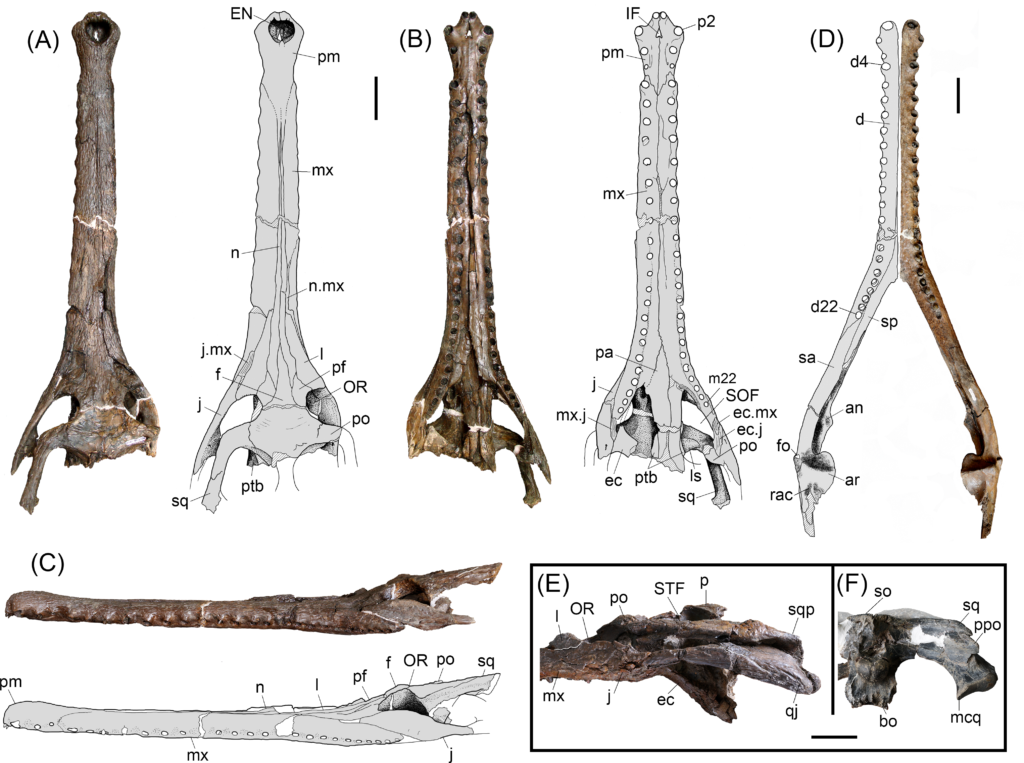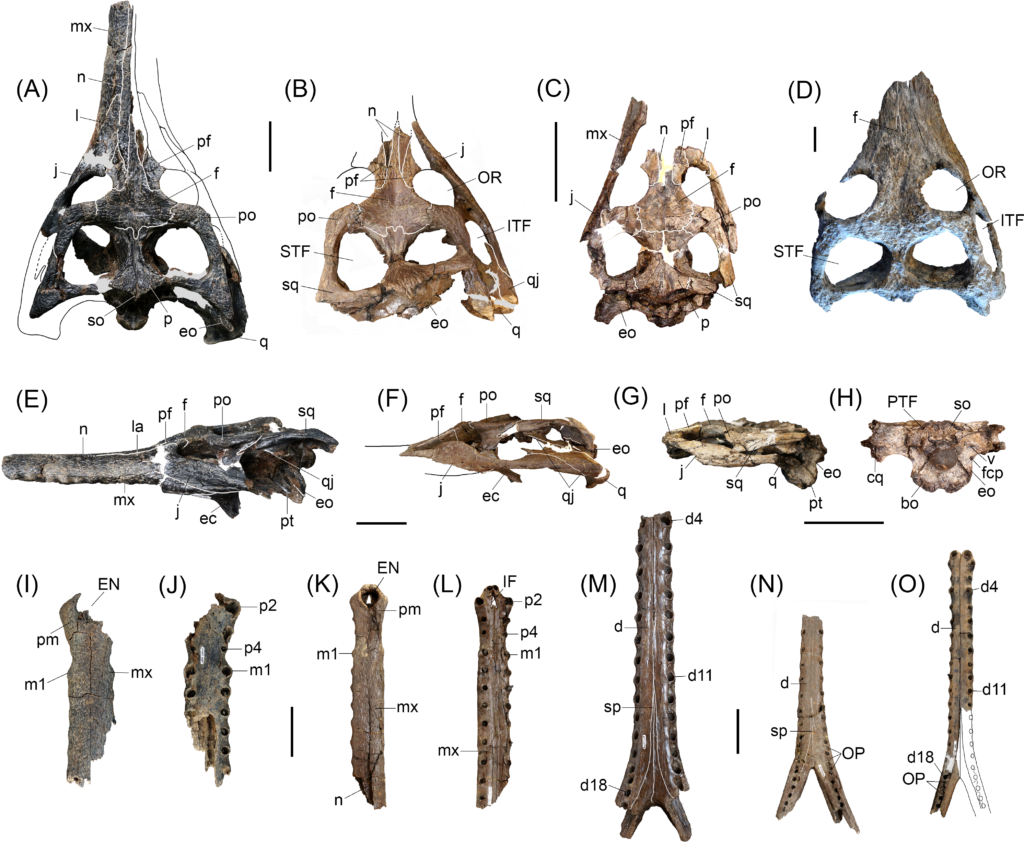Citation: Salas-Gismondi R, Flynn JJ, Baby P, Tejada-Lara JV, Claude J, Antoine P-O (2016) A New 13 Million Year Old Gavialoid Crocodylian from Proto-Amazonian Mega-Wetlands Reveals Parallel Evolutionary Trends in Skull Shape Linked to Longirostry. PLoS ONE 11(4): e0152453. doi:10.1371/journal.pone.0152453
Editor: Laurent Viriot, Team ‘Evolution of Vertebrate Dentition’, FRANCE
ABSTRACT: Gavialoid crocodylians are the archetypal longirostrine archosaurs and, as such, understanding their patterns of evolution is fundamental to recognizing cranial rearrangements and reconstructing adaptive pathways associated with elongation of the rostrum (longirostry). The living Indian gharial Gavialis gangeticus is the sole survivor of the group, thus providing unique evidence on the distinctive biology of its fossil kin. Yet phylogenetic relationships and evolutionary ecology spanning ~70 million-years of longirostrine crocodylian diversification remain unclear. Analysis of cranial anatomy of a new proto-Amazonian gavialoid, Gryposuchus pachakamue sp. nov., from the Miocene lakes and swamps of the Pebas Mega-Wetland System reveals that acquisition of both widely separated and protruding eyes (telescoped orbits) and riverine ecology within South American and Indian gavialoids is the result of parallel evolution. Phylogenetic and morphometric analyses show that, in association with longirostry, circumorbital bone configuration can evolve rapidly for coping with trends in environmental conditions and may reflect shifts in feeding strategy. Our results support a long-term radiation of the South American forms, with taxa occupying either extreme of the gavialoid morphospace showing preferences for coastal marine versus fluvial environments. The early biogeographic history of South American gavialoids was strongly linked to the northward drainage system connecting proto-Amazonian wetlands to the Caribbean region.
Information through WFS,World Fossil Society,Riffin T Sajeev,Russel T Sajeev

Gryposuchus pachakamue sp. nov.
Photograph and schematic drawing of the skull (holotype, MUSM 1981) in dorsal (A), ventral (B), and lateral (C) view. (D) Photograph of the right mandible (MUSM 987) and schematic drawing in dorsal view. Details of the skull (E,F). (E) MUSM 900 in lateral view. (F) MUSM 1681 in occipital view. Abbreviations: an, angular; ar, articular; bo, basioccipital; d, dentary; d4, d22, dentary tooth positions; ec, ectopterygoid; ec.j, jugal surface for ectopterygoid; ec.mx, maxilla surface for ectopterygoid; EN, external nares; eo, exoccipital; f, frontal; fo, foramen; IF, incisive foramen; j, jugal; j.mx, maxilla surface for the jugal; l, lacrimal; ls, laterosphenoid; m22, maxillary tooth position 22; mcq, medial condyle of the quadrate; mx, maxilla; mx.j, jugal surface for maxilla; n.mx, maxilla surface for nasal; n, nasal; OR, orbit; p, parietal; pa, palatine; pf, prefrontal; pm, premaxilla; p2, premaxillary tooth position 2; po, postorbital; ppo, paraoccipital process; pt, pterygoid; ptb, pterygoid bullae; q, quadrate; qj, quadratojugal; qj.q, quadrate surface for quadratojugal;; rac, retroarticular crest; sp, splenial; sa, surangular; so, supraoccipital; sq, squamosal; SOF, suborbital fenestra; STF, supratemporal fenestra. Scale bars, 5 cm.
Cranial and mandibular specimens referred to Gryposuchus pachakamue sp. nov.
(A-C,E-O) Gryposuchus pachakamue from the Middle Miocene of the Pebas Formation, Peru and (D) Gryposuchus cf. pachakamue from the Late Miocene of Urumaco, Venezuela. (A,E) Skull in dorsal (A) and lateral (E) view (MUSM 1681); (B,F) Skull in dorsal (B) and lateral (F) view (MUSM 2032); (C,G,H) Skull in dorsal (C), lateral (G), and occipital (H) view, juvenile (MUSM 1988); (D) Skull in dorsal view (AMU CURS 12). (I,J) Snout in dorsal (I) and (J) ventral view (MUSM 1681). (K,L) Snout in dorsal (K) and ventral (L) view, juvenile (MUSM 1727). (M) Symphyseal mandible in dorsal view (MUSM 2407). (N) Symphyseal mandible in dorsal view, juvenile (MUSM 1439). (O) Symphyseal mandible in dorsal view, juvenile (MUSM 1682). Abbreviations: cqg, cranio-quadrate groove; d, dentary; d4, d11, d18, dentary tooth positions; ec, ectopterygoid; EN, external nares; eo, exoccipital; f, frontal; fcp, foramen carotideum posterior; IF, incisive foramen; ITF, infratemporal fenestra; j, jugal; l, lacrimal; m1, maxillary tooth position 1; mx, maxilla; n, nasal; OP, occlusal pits; OR, orbit; p, parietal; p1, p2, p4, premaxillary tooth positions; pm, premaxilla; po, postorbital; pr, prefrontal; pt, pterygoid; PTF, post-temporal fenestra; q, quadrate; qj, quadratojugal; so, supraoccipital; sp, splenial; sq, squamosal; STF, supratemporal fenestra; v, foramen vagus. Scale bars, 5 cm.



 April 22nd, 2016
April 22nd, 2016  Riffin
Riffin 
 Posted in
Posted in  Tags:
Tags: 